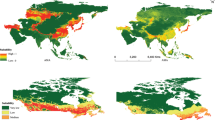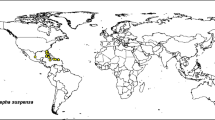Abstract
The gypsy moth is a global pest that has not yet established in New Zealand despite individual moths having been discovered near ports. A climate-driven phenology model previously used in North America was applied to New Zealand. Weather and elevation data were used as inputs to predict where sustainable populations could potentially exist and predict the timing of hatch and oviposition in different regions. Results for New Zealand were compared with those in the Canadian Maritimes (New Brunswick, Nova Scotia, and Prince Edward Island) where the gypsy moth has long been established. Model results agree with the current distribution of the gypsy moth in the Canadian Maritimes and predict that the majority of New Zealand’s North Island and the northern coastal regions of the South Island have a suitable climate to allow stable seasonality of the gypsy moth. New Zealand’s climate appears more forgiving than that of the Canadian Maritimes, as the model predicts a wider range of oviposition dates leading to stable seasonality. Furthermore, we investigated the effect of climate change on the predicted potential distribution for New Zealand. Climate change scenarios show an increase in probability of establishment throughout New Zealand, most noticeably in the South Island.









Similar content being viewed by others
References
Allen JC (1976) A modified sine wave method for calculating degree days. Environ Entomol 5:388–396
Benoit P, Lachance D (1990) Gypsy moth in Canada: behavior and control. Forestry Canada. Canadian Forest Service, 351 St. Joseph Blvd., Hull, Quebec. K1A 1G5. Information Report DPC-X-32
Cowley J, Bain J, Walsh P, Harte R, Baker R, Hill C, Whyte C, Barber C (1993) Pest Risk Assessment for Asian Gypsy Moth. Lymantria dispar L. (Lepidoptera:Lymantriidae). New Zealand Forest Research Institute
Cressie N (1993) Statistics for spatial data. Wiley, New York
Dukes JS, Mooney HA (1999) Does global change increase the success of biological invaders? Trends Ecol Evol 14:135–139
Dunlap T (1980) The gypsy moth. A study in science and public policy. J For Hist 24:116–126
Ferguson D (1978) The Moths of North America north of Mexico including Greenland. Fascicle. E.W. Classey Ltd and the Wedge Entomological Research Foundation, pp 90–95
Garner KJ, Slavicek JM (1996) Identification and characterisation of a RAPD-PCR marker for distinguishing Asian and North American gypsy moths. Insect Mol Biol 5:81–91
Glare TG, Walsh PJ, Barlow ND (1997) Strategies for the eradication or control of gypsy moth in New Zealand. AgResearch Internal Report
Gray DR (2004) The gypsy moth life stage model: landscape-wide estimates of gypsy moth establishment using a multi-generational phenology model. Ecol Model 176:155–171
Gray DR, Logan JA, Ravlin FW, Carlson JA (1991) Toward a model of gypsy moth phenology: using respiration rates of individual eggs to determine temperature-time requirements of prediapause development. Environ Ecol 20:1645–1652
Gray DR, Ravlin FW, Régnière J, Logan JA (1995) Further advances toward a model of gypsy moth (Lymantria dispar (L.)) egg phenology: Respiration rates and thermal responsiveness during diapause, and age-dependent developmental rates in postdiapause. J Insect Physiol 41:247–256
Gray DR, Ravlin FW, Braine JA (2001) Diapause in the gypsy moth: a model of inhibition and development. J Insect Physiol 47:173–184
Hoy MA (1977) Rapid response to selection for a nondiapausing gypsy moth. Science 196:1462–1463
Hurley JE, Magasi LP (1995) Forest pest conditions in the maritimes in 1994. Canadian Forest Service, Fredericton, NB, Information Report M-X-194E
Hurley JE, Magasi LP (1996) Forest pest conditions in the maritimes in 1995. Canadian Forest Service, Fredericton, NB, Information Report M-X-199E
Liebhold A, Gottschalk K, Muzika R, Montgomery M, Young R, O’Day K, Kelly B (1995) Suitability of north american tree species to the gypsy moth: a summary of field and laboratory tests. USDA General Technical Report NE-211. USDA, Forest Service, Delaware, OH
Liebhold A, Halverson J, Elmes G (1992) Gypsy moth invasion in North America: A quantitative analysis. J Biogeography 19:513–520
Logan JA, Casagrande RA, Liebhold AM (1991) A modeling environment for simulation of gypsy moth larval phenology. Environ Entomol 20:1516–1525
Logan JA, Régnière J, Powell JA (2003) Assessing the impacts of global warming on forest pest dynamics. Front Ecol Environ 1:130–137
Logan J, Régnière J, Gray D, Munson A (2006) Risk assessment in face of a changing environment: Gypsy moth and climate change in Utah. Ecol Appl (in press)
Magasi LP (1991) Forest pest conditions in the maritimes in 1990. Canadian Forest Service, Fredericton, NB, Information Report M-X-178
Magasi LP (1992) Forest pest conditions in the maritimes in 1991. Canadian Forest Service, Fredericton, NB, Information Report M-X-181E
Magasi LP (1993) Forest pest conditions in the maritimes in 1992. Canadian Forest Service, Fredericton, NB, Information Report M-X-183E
Magasi LP, Hurley JE (1994) Forest pest conditions in the maritimes in 1994. Canadian Forest Service, Fredericton, NB, Information Report M-X-188E
Matsuki M, Kay M, Serin J, Floyd R, Scott JK (2001) Potential risk of accidental introduction of Asian gypsy moth (Lymantria dispar) to Australasia: effects of climatic conditions and suitability of native plants. Agricult Forest Entomol 3:305–320
Ministry for the Environment (2004) Climate change effects and impacts assessment: A guidance manual for local government in New Zealand
Nealis VG, Erb S (1993) A sourcebook for management of the gypsy moth. Canadian Forestry Service, Sault Ste-Marie, ON. Catalogue No. Fo42-193/1993E
Régnière J (1996) A generalized approach to landscape-wide seasonal forecasting with temperature-driven simulation models. Environ Entomol 25:869–881
Régnière J (2006) Stochastic simulation of daily air temperature and precipitation from monthly normals in North America. Int J Biometeorology (in press)
Régnière J, Bolstad P (1994) Statistical simulation of daily air temperature patterns in eastern north america to forecast seasonal events in insect pest management. Environ Entomol 23:1368–1380
Régnière J, Nealis V (2002) Modelling seasonality of gypsy moth, Lymantria dispar, to evaluate probability of its persistance in novel environments. Can Entomol 134:805–824
Ross MG (2004) Response to a gypsy moth incursion within New Zealand. In: IUFRO conference, Hanmer, 2004. Biosecurity New Zealand, MAF
Sample BE, Butler L, Zivkovich C, Whitmore RC, Reardon R (1996) Effects of Bacillus thuringiensis berliner var. Kurstaki and defoliation by the gypsy moth [Lymantria dispar (L.) (Lepidoptera: Lymantriidae)] on native arthropods in West Virginia. Can Entomol 128:573–592
Sharov AA, Leonard D, Liebhold AM, Roberts EA, Dickerson W (2002) Slow the spread: a national program to contain the gypsy moth. J Forestry 100:30–35
Sheehan KA (1992) Users guide for GMPHEN: Gypsy moth phenology model. General Technical Report NE-158. USDA Forest Service
Sutherst R, Maywald G, Yonow T, Stevens P (1999) CLIMEX: predicting the effects of climate on plants and animals. CSIRO Publishing, Collingwood, Australia
Wallner WE (1996) Invasion of the tree snatchers. Am Nurseryman, March:41–43
Walsh P (1993) Asian gypsy moth: the risk to New Zealand. N Z Forestry 38:31–43
Acknowledgements
This research was funded by the National Center for Advanced Bio-protection Technologies, Lincoln University, New Zealand. Thanks to J.E. Hurley (Canadian Forestry Service, Atlantic Forestry Centre, Fredericton, NB, Canada) for the compilation of EGM records from the Maritime provinces. Thanks to Rémi St-Amant (Canadian Forest Service, Quebec City, QC, Canada) for help with model alterations. The National Institute of Water and Atmospheric Research (NIWA) of New Zealand allowed us use of historical New Zealand weather data from 1972 to 2005.
Author information
Authors and Affiliations
Corresponding author
Rights and permissions
About this article
Cite this article
Pitt, J.P.W., Régnière, J. & Worner, S. Risk assessment of the gypsy moth, Lymantria dispar (L), in New Zealand based on phenology modelling. Int J Biometeorol 51, 295–305 (2007). https://doi.org/10.1007/s00484-006-0066-3
Received:
Revised:
Accepted:
Published:
Issue Date:
DOI: https://doi.org/10.1007/s00484-006-0066-3




